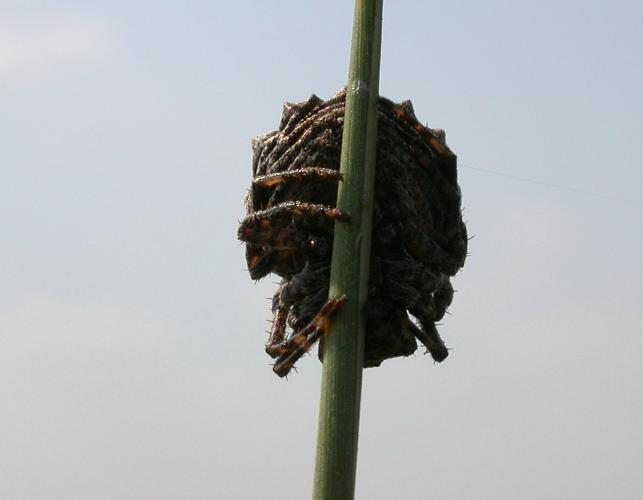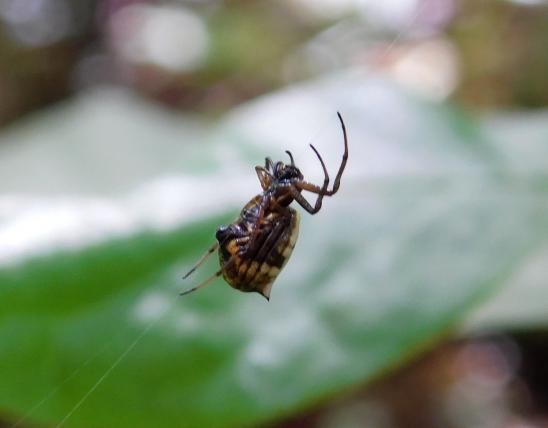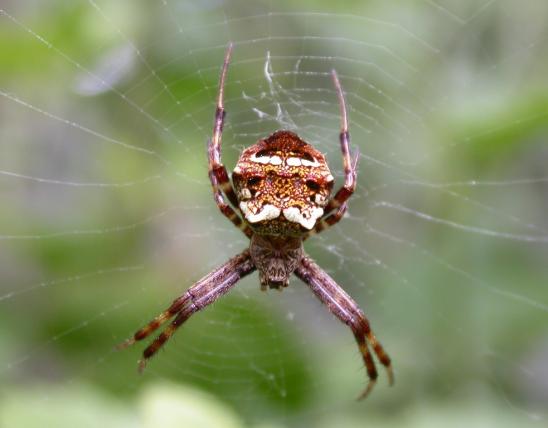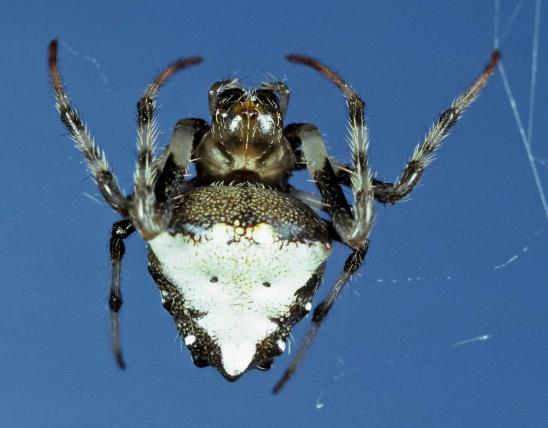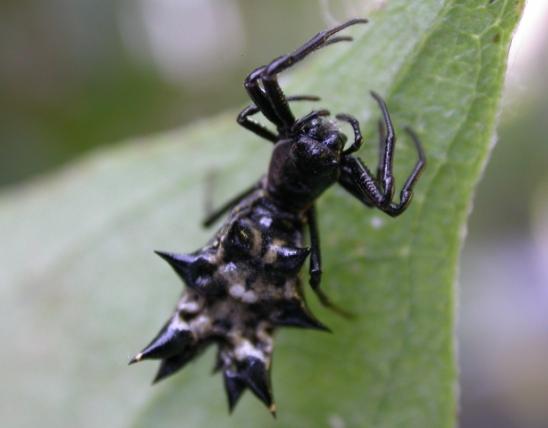
Mature female starbellied orbweavers spin vertical, wheel-shaped webs in prairies and other open, sunny habitats. Individuals are usually tan, brown, or gray but may be yellowish, orangish, or slightly olive. The abdomen is decorated with 12 spines that poke outward around the outer margin of the back (dorsal side), looking something like a crown. Most individuals also have a star-shaped color pattern on the back (dorsal) surface of the abdomen, though some have a relatively plain pattern.
Males are much smaller than females and are rarely seen. Like many other male spiders, they are identified as males by the pair of enlarged palps next to the mouth. Most people only see them when they are visiting the webs of females.
Specialists use details (shapes and configuration) of the eyes, reproductive anatomy, and other body parts to verify the identifications of spiders.
Similar species: Four species of spiders in genus Acanthepeira occur in North America north of Mexico. A. stellata, the starbellied orbweaver, is the most common and widespread.
- A. marion and A. cherokee (no common names) also occur in Missouri, with their overall ranges mostly in the southeastern United States. Neither of these species have the distinctive star-shaped color pattern on the back of the abdomen, and their backs are not as spiny (the protrusions are more like humps or mounds than true spines). Also, A. cherokee lives in moist, low woodlands and is less likely to be found in sunny grassy habitats.
- America’s fourth species, A. venusta, does have a kind of starburst pattern on its back and has pointy spines, but it does not occur in Missouri (it ranges from Florida to Virginia).
There are several other small, orbweaving spiders that have spines or bumps on their abdomens. In our state, the three species of micrathenas, the arrowhead spider (triangle orbweaver), the heptagonal orbweaver, two species of trashline orbweavers, and the featherlegged orbweaver might be confused with members of genus Acanthepeira, but a comparison of photos should easily sort them out.
Length (not counting appendages): ¼ to ⅝ inch (females); males only about ¼ inch.
Statewide.
Habitat and Conservation
The starbellied orbweaver lives in prairies and other open, sunny habitats, building vertical wheel-shaped webs within about 4 feet from the ground. The circular webs are about 1 foot in diameter. The female usually sits in the center of the web, head-down.
When disturbed, these spiders quickly clamber onto nearby vegetation or else drop quickly to the ground. A frightened starbellied orbweaver draws up her legs tightly against her body, playing dead, and she looks like nothing more than a chunk of dirt, or a fleck of dried-up plant material.
Food
Like most other orbweaving spiders, starbellied orbweavers spin webs that ensnare flying insects. The spider uses a venomous bite to subdue the insect. The spider’s venom also digests the insect’s internal organs, enabling the spider to drink the liquified contents of the insect.
Remember that nearly all spiders, and several types of insects (such as wasps, wheel bugs, and diving beetles), use venom to subdue their prey, but only a few species of Missouri spiders can pose health problems for people. The starbellied orbweaver is considered harmless to people.
Status
Native Missouri orbweaving spider, most common in grasslands. Harmless to people. Considered beneficial because they prey on flying insects.
Life Cycle
Mature starbellied orbweavers may be found starting in middle to late spring and are present until late fall or early winter, when hard frosts and freezes zap the adults. The egg cases are wrapped in a ball of brown or tan silk and attached to leaves and other nearby vegetation. As with most spiders, the baby spiders emerge from the egg cases in springtime and grow to mature, full size by midsummer, when they mate and start producing more egg cases.
Human Connections
As with the vast majority of Missouri’s spiders, this species poses no threat to humans, except for the rare individual who is exceptionally allergic to the venom. Its ecological role of capturing flying insects is something humans should appreciate. This spider is a natural, free pest-control agent helping to keep populations of mosquitoes and other insects in check.
The species name, stellata, means “starred” and could refer to the starlike crown of spines or to the star-shaped color pattern. Note that “belly” in the common name refers to the entire abdominal portion of the spider’s body, and not the ventral side (underside) of the abdomen.
The meaning of the genus name, Acanthepeira, at first seems obscure. Acanth- is from the Greek word for “spine” or “thorn.” Epeira is an old, catch-all genus name once applied to several types of orbweavers. It is derived from epi- (meaning "on" or "upon") plus the Greek word eirein, (meaning "weave" or "string"), and means "to fasten in rows" or "string together." Thus the genus name means "spiny orbweaver."
Ecosystem Connections
The starbellied orbweaver and other spiders prey on a wide variety of insects, helping to control insect populations.
Meanwhile, these small predators are eaten by a wide variety of larger predators ranging from birds to amphibians, reptiles, and mammals. Even among invertebrates, spider wasps, robber flies, assassin bugs, and other spiders will eat them, given the chance. The starbellied orbweavers’ habit of dropping to the ground, plus the defensive posture with legs tucked against the tough body, along with the spines and camouflage coloration, all serve to protect them from predators.
Many animals feign death to escape predation, including opossums, hog-nosed snakes, wood ducks, mallards, and more. In many cases, this behavior isn’t an “act” so much as it is a kind of unconsciousness caused by sheer fright. “Playing dead” may persuade the attacker to give up, or it may cause the attacker to hesitate long enough for the prey species to escape. In the case of this spider, feigning death probably makes it nearly impossible to be located against the ground, surrounded by a jumble of grass stalks and other plants.
The camouflaged egg cases are eaten by birds and other animals, notably in the winter when they are perhaps easier to find.



